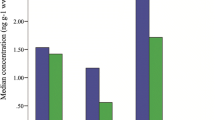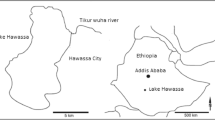Abstract
Residues of potentially toxic non-ortho chlorine substituted coplanar 3,3′,4,4′-tetra-,3,3′,4,4′,5-penta-, 3,3′,4,4′,5,5′-hexachlorobiphenyl and their mono- and di-ortho analogs (2,3′,4,4′,5-penta-, 2,3,3′,4,4′-penta-, 2,3,3′,4,4′,5-hexa-and 2,2′,3,3′,4,4′-hexa-, 2,2′,3,4,4′,5-hexa-chlorobiphenyl) were determined in humans, dogs, cats (terrestrial), a finless porpoise (Neophocoena phocoenoides-coastal), Dall's porpoises (Phocoenoides dalli,dalli), Baird's beaked whales (Berardius bairdii) and killer whales (Orcinus orca-open ocean). Among the coplanar polychlorinated biphenyl (PCB) congeners, the concentration of the di-ortho congeners was the highest and the non-ortho congeners was the lowest. However, all three coplanar PCBs occurred at significantly higher levels than toxic polychlorinated dibenzo-p-dioxins (PCDDs) and polychlorinated dibenzofurans (PCDFs). The relative bioconcentration and metabolic capacity of terrestrial and marine mammals to these chemicals, suggest that the toxic threat of coplanar PCBs increases from land to ocean, but the reverse is true for PCDDs and PCDFs. The toxic threat of coplanar PCBs to higher aquatic predators such as cetaceans was principally assessed by 2,3,7,8-T4CDD Toxic Equivalent Analysis which is based on the induction of arylhydrocarbon hydroxylase (AHH) and ethoxyresorufinO-deethylase (EROD). Analysis indicates, in particular, that the bioaccumulation of toxic 3,3′,4,4′,5-penta- and 2,3,3′,4,4′-pentachlorobiphenyls in carnivorous marine mammals is a cause for considerable concern.
Similar content being viewed by others
References
Bidleman TF (1984) Estimation of vapor pressure for nonpolar organic compounds by capillary gas chromatography. Anal Chem 56:2490–2496
Birnbaum LS, Weber H, Harris MW, Lamb JC, McKinney JD (1985) Toxic interaction of specific polychlorinated bi phenyls and 2,3,7,8-tetrachlorodibenzo-p-dioxin: increased incidence of cleft palate in mice. Toxicol Appl Pharmacol 77:292–302
Boon JP, Reijnders PJH, Dols J, Wensvoort P, Hillebrand MTJ (1987) The kinetics of individual polychlorinated biphenyl congeners in female harbour seals (Phoca vitulina) with evidence for structure-related metabolism. Aquat Toxicol 10:307–324
Bradlaw JA, Casterline JL (1979) Induction of enzyme activity in cell culture: A rapid screen for detection of planar poly chlorinated organic compounds. J Assoc Offic Anal Chem 62:904–916
Bryan AM, Stone WB, Olafsson PG (1987) Disposition of toxic PCB congeners in snapping turtle eggs: expressed as toxic equivalents of TCDD. Bull Environ Contam Toxicol 39:791–796
Czuczwa JM, Hites RA (1986) Airborne dioxins and dibenzo furans in the atmosphere: source and fates. Environ Sci Technol 20:195–200
Haake JM, Safe S, Mayura K, Phillips TD (1987) Aroclor ® 1254 as an antagonist of the teratogenicity of 2,3,7,8-tetrachloro dibenzo-p-dioxin. Toxicol Lett 38:299–306
Harris HJ, Kubiak TJ, Trick JA (1985) Microcontaminants and reproductive impairment of Forster's Tern on Green Bay. Final report to U.S. Fish and Wildlife Service, Univ. of Wis consin Sea Grant Institute, Wis. Dept. of Nat. Res. and Green Bay Metropolitan Sewerage District, Sea Grant Of fice ES-105, Univ of Wisconsin, Green Bay, WI, p 42
Hutzinger O, Blumich MJ, v.d. Berg M, Olie K (1985) Sources and fate of PCDDs and PCDFs: an overview. Chemosphere 14:581–600
Kannan N, Tanabe S, Wakimoto T, Tatsukawa R (1987a) Co planar PCBs in Aroclors and Kanechlors. J Assoc Off Anal Chem 70:451–454
— (1987b) A simple method for determiningnon-ortho Cl substituted PCBs in Kanechlors, Aroclors and environ mental samples. Chemosphere 16:1631–1634
Kannan N, Tanabe S, Tatsukawa R (1988) Potentially hazardous residues of non-ortho chlorine substituted coplanar PCBs in human adipose tissue. Arch Environ Health 43:11–14
McKinney JD, Chae K, McConnel EE, Birnbaum LS (1985) Structure-induction versus structure-toxicity relationships for polychlorinated biphenyls and related aromatic hydrocarbons. Environ Health Perspect 60:57–68
Olafsson PG, Bryan AM, Stone W (1987) PCB congener-specific analysis: a critical evaluation of toxic levels in biota. Chemosphere 16:2585–2593
Ono M, Wakimoto T, Tatsukawa R, Masuda Y (1986) Polychlorinated dibenzo-p-dioxins and dibenzofurans in human adipose tissues of Japan. Chemosphere 15:1629–1634
Ono M, Kannan N, Wakimoto T, Tatsukawa R (1987) Dibenzofurans a greater global pollutant than dioxins? Evidences from analyses of open ocean killer whale. Mar Pollut Bull 18:640–643
Parkinson A, Safe S, Robertson LW, Thomas PE, Ryan DE, Reik LM, Levin W (1983) Immunochemical quantitation of cytochrome P-450 isozymes and epoxide hydroxyiase in liver microsomes from polychlorinated biphenyl treated rats. J Bio Chem 258:5967–5976
Podoll RT, Jaber HM, Mill T (1986) Tetrachlorodibenzo-p-dioxin: rates of volatilization and photolysis in the environment. Environ Sci Technol 20:490–492
Safe S (1984) Polychlorinated biphenyls (PCBs) and polybrominated biphenyls (PBBs): Biochemistry, toxicology, mechanism of action. CRC Crit Rev Toxicol 13:319–395
— (1987) Determination of 2,3,7,8-T4CDD toxic equivalent factors (TEFs): Support for the use of thein vitro AHH induction assay. Chemosphere 16:791–802
Safe S, Bandiera S, Sawyer T, Robertson L, Safe L, Parkinson A, Thomas PE, Ryan DE, Reik LM, Levin W, Denomme M, Fujita T (1985a) PCBs: structure-function relationships and mechanism of action. Environ Health Perspect 60:47–56
Safe S, Safe L, Mullin M (1985b) Polychlorinated biphenyls: congener-specific analysis of a commercial mixture and a human milk extract. J Agric Food Chem 33:24–29
Tanabe S, Tatsukawa R (1986) Distribution, behavior and load of PCBs in the oceans. In: Waid JS (ed) PCBs and the environment. Vol I, CRC Press Inc, Boca Raton, FL, pp 143–161
Tanabe S, Kannan N, Wakimoto T, Tatsukawa R (1987a) Method for the determination of three toxic non-ortho chlorine substituted coplanar PCBs in environmental samples at parts per trillion levels. Intern J Environ Anal Chem 29:199–213
Tanabe S, Kannan N, Subramanian An, Watanabe S, Tatsukawa R (1987b) Highly toxic coplanar PCBs: Occurrence, source, persistency and toxic implications. Environ Pollut 47:147–163
Tanabe S, Tatsukawa R, Phillips DJH (1987c) Mussels as bioindicators of PCB pollution: A case study on uptake and release of PCB isomers and congeners in green-lipped mussels (Perna viridis) in Hong Kong waters. Environ Pollut 47:41–62
Tanabe S (1988) PCB problems in the future: Foresight from current knowledge. Environ Pollut 50:5–28
Tanabe S, Watanabe S, Kan H, Tatsukawa R (1988) Capacity and mode of PCB metabolism in small cetaceans. Marine Mammal Sci 4:103–124
Yoshimura H, Wada I, Koga N, Nagata K, Yamauchi Y, Yoshihara S, Kamata O (1981) Acute toxicity and inductive effect on liver enzymes of 3,4,5,3′,4′-pentachlorobiphenyl in guinea pigs. Fukuoka Acta Med 72:149–154
Wakimoto T, Tatsukawa R, Ogawa T (1971) Analytical method of PCBs, J Environ Pollut Cont 7:517–522
Author information
Authors and Affiliations
Rights and permissions
About this article
Cite this article
Kannan, N., Tanabe, S., Ono, M. et al. Critical evaluation of polychlorinated biphenyl toxicity in terrestrial and marine mammals: Increasing impact of non-ortho and mono-ortho coplanar polychlorinated biphenyls from land to ocean. Arch. Environ. Contam. Toxicol. 18, 850–857 (1989). https://doi.org/10.1007/BF01160300
Received:
Revised:
Issue Date:
DOI: https://doi.org/10.1007/BF01160300




